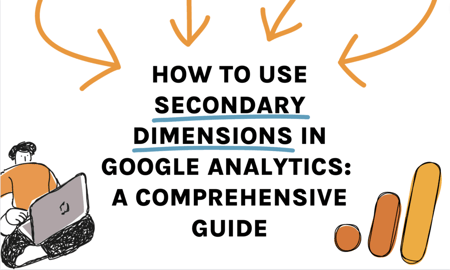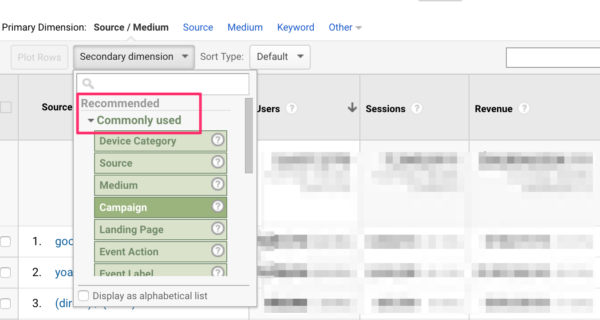SEO Proficiency: Deep Study Secondary Dimensions for Exact Metrics
Wiki Article
Enhance Your Information Analysis Utilizing Second Measurements
In the world of information analysis, main metrics frequently give a foundational understanding of efficiency or fads. The true deepness of insights lies in the combination of additional measurements. These added layers of information use a nuanced sight that can decipher nuances and complexities not apparent initially look. The capacity to dissect details via various lenses opens doors to a realm of possibilities that can transform how companies act and translate upon their data. The critical use of additional dimensions elevates evaluation beyond the surface degree, guaranteeing a wide range of untapped possible waiting to be found.Recognizing Secondary Dimensions
Secondary measurements in data analysis refer to additional qualities or metrics that provide much deeper insights when integrated with primary data measurements, boosting the total understanding of the dataset. These added measurements offer an even more thorough view of the information, enabling experts to discover covert patterns, partnerships, and patterns that may not be noticeable when only considering main dimensions.By incorporating additional measurements right into information evaluation, experts can get a more nuanced understanding of the factors affecting the key metrics. For instance, in advertising evaluation, main measurements could include fundamental consumer demographics like age and gender, while additional dimensions can incorporate variables such as buying behavior, choices, or geographical location. By combining these additional and primary measurements, experts can create much more detailed client accounts, allowing more targeted and reliable marketing strategies.
Furthermore, second dimensions can help in recognizing correlations in between different variables, bring about more precise anticipating modeling and decision-making. They enable analysts to discover data from several viewpoints, enhancing the understandings drawn from the dataset and ultimately enhancing the quality of analysis and tactical suggestions.
Advantages of Additional Dimensions
When taking into consideration information evaluation, incorporating additional dimensions provides a wide range of advantages that dramatically improve the depth and breadth of understandings obtained from primary information measurements. By adding additional measurements such as time, area, or group details to the evaluation, scientists can obtain an extra detailed understanding of the primary information factors.Additionally, secondary dimensions can additionally aid in segmenting information, allowing for a much more in-depth evaluation of particular parts within the key data. This segmentation can lead to more targeted techniques and actions based upon the special features of each section. In addition, secondary measurements can help in confirming searchings for from primary information dimensions, giving a much more reliable and durable basis for decision-making.
Basically, the benefits of incorporating additional measurements right into data evaluation are very useful, using richer insights and making it possible for more informed decision-making procedures.
Executing Second Dimensions Successfully
When integrating additional dimensions, it is look at here crucial to align them with the main dimensions to acquire deeper understandings right into the information. It is vital to choose secondary dimensions that complement the primary information without creating noise or confusion in the evaluation.visit In addition, take into consideration the scalability of the second dimensions across various datasets or analyses. Guarantee that the chosen second measurements can be regularly applied and translated across various situations to keep the stability and consistency of the analysis. Furthermore, establish a systematic process for incorporating additional measurements into the evaluation operations to enhance the interpretation of results. By implementing secondary measurements effectively, analysts can enhance the depth and accuracy of their information analysis, causing even more educated decision-making and workable understandings.
Advanced Techniques With Additional Dimensions
For a more advanced method to data analysis, integrating secondary measurements can dramatically boost the depth of understandings gotten. Advanced strategies with second dimensions involve even more intricate approaches to draw out important details from information collections. One such strategy is associate analysis, where data is fractional you can try here based on specific characteristics or habits to track patterns with time. This method enables for a deeper understanding of how various groups communicate and advance with your service or product.An additional sophisticated method is regression evaluation, which helps identify relationships in between variables and how they influence each various other. By adding additional dimensions, such as market info or user actions, to regression versions, you can discover much more nuanced insights and make more precise forecasts.

Case Research Studies: Additional Measurements in Action

In one more circumstance, a doctor leveraged additional measurements to maximize resource allowance. By assessing person results in regard to geographical area, the company determined areas with high readmission rates. This caused the execution of targeted treatment programs in those regions, ultimately boosting patient treatment and reducing healthcare prices.
These case studies illustrate the power of additional dimensions in discovering important understandings that drive strategic decision-making. By delving deeper into information evaluation past key metrics, organizations can obtain a more extensive understanding of their operations and customers, leading to even more educated and efficient organization approaches.
Verdict
Finally, the incorporation of second measurements in information evaluation is essential for obtaining a comprehensive understanding of underlying patterns and factors. By making use of methods such as mate evaluation and regression analysis, organizations can discover hidden insights and make more enlightened decisions. Secondary dimensions add depth and breadth to data evaluation, permitting companies to check out information from numerous perspectives and drive a lot more efficient results.In advertising and marketing evaluation, main measurements could consist of basic client demographics like age and gender, while secondary dimensions could include variables such as buying habits, choices, or geographic place.When taking into consideration information analysis, integrating secondary dimensions uses a wide range of advantages that significantly enhance the deepness and breadth of understandings acquired from main information dimensions.Additionally, secondary measurements can additionally assist in segmenting data, allowing for a much more comprehensive evaluation of certain subsets within the key information. In addition, secondary dimensions can help in verifying findings from key data dimensions, supplying an extra reputable and robust basis for decision-making.
When integrating additional measurements, it is essential to align them with the key measurements to gain deeper insights into the data.
Report this wiki page